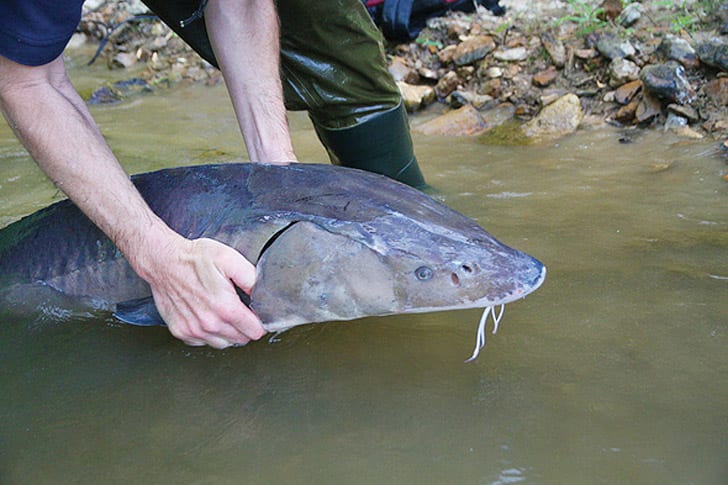The Missouri Department of Conservation (MDC) has a pretty cool story to tell about the lengths lake sturgeon will travel for a little lovin’.
Giant lake sturgeon can to grow to lengths approaching 8 feet and weigh as much 300 pounds. They require 25-30 years to arrive at reproductive maturity, and can reach ages of 100-150 years. Lake sturgeon evolved more than 150 million years ago during the time of the dinosaurs.
Lake sturgeon were once common in North America’s big rivers, but by the 1970s overharvest and habitat decline caused their numbers to plummet. MDC listed the species as a state endangered fish in 1974 and banned their harvest. Since 1984, MDC and U.S. Fish and Wildlife Service (USFWS) staff have partnered to raise and stock fingerling lake sturgeon into Missouri’s big rivers.
Those efforts paid off in 2015, when lake sturgeon were confirmed spawning in the Mississippi River near West Alton, Missouri. During that time, one particular sturgeon on the reproductive move somehow managed to swim up a tributary of the Mississippi and was trapped in a pool of Dardenne Creek in St. Charles County, Missouri. The intrepid fish gained some local notoriety and became known as “Norman” by the public.
Travis Moore, head of MDC’s Lake Sturgeon Recovery Team, inserted a radio transmitter into the fish at that time to track its movements. St. Louis regional Fisheries Management Biologist Sarah Peper and her crew returned Norman to the Mississippi River.
This past spring, a bleep picked up by a USFWS receiver at Keokuk, Iowa, raised the eyebrows of fisheries biologists in Missouri. It was Norman. He had travelled over 170 river miles through six locks and dams.
“I think its kind cool that this guy is wandering around looking for some ‘ladies,’” said Peper. “He’s made his way through six dams.”
According to Peper, during high water the Army Corps of Engineers often sets the gates of the dams wide open, allowing fish to swim through. It’s also possible Norman could have locked through with a barge.
Norman is currently still hanging out downriver of Lock and Dam 19 at Keokuk. It remains to be seen if he will make it through that one, too.
Norman’s story does not appear to be unique, however.
Other tagged lake sturgeon have been reported 130 and 170 river miles away from the tagging sites. And Moore offered statistics on an even longer journey.
“A fish that was tagged in 2008 at Pool 24 near Hannibal, moved upstream to Keokuk, then he was caught six years later in 2014 in the Arkansas River,” he said. The distance between Keokuk and the confluence of the Mississippi and Arkansas Rivers is about 600 miles.
Collectively, these sturgeon travelled through four states and well over a thousand miles through the Mississippi River and its tributaries. This all points to one important fact fisheries researchers are discovering: fish know no state boundaries and all our rivers and streams are truly connected. It’s one grand, overarching macrocosm.
The story of Norman and his fellow lake sturgeon travelers is still being written. But so far it is pretty amazing. Giant endangered prehistoric fish are multiplying again, and they journey thousands of miles through locks and dams to do it.
